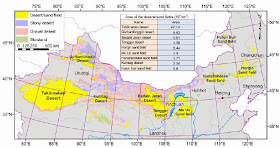There is around 2 million km² of desert and semi-desert across northern China (excluding the Tibetan Plateau), which has played an important role in the development of China as a nation, and still affects the modern Chinese economy. The desert areas provide a boundary between China and the Mongolian and Siberian steppes to the north, but also occupy a large area of land which could otherwise potentially be used for agriculture, thus improving China's food security. In addition soils blown from these areas by the wind (loess) are thought to have played a major role in the formation of the rich agricultural lands of the middle and upper Yellow River region, which has historically served as China's breadbasket, but is also considered to be a major contributor to air pollution in Beijing and other northern cities that are frequently enveloped by dust storms. The climate and precipitation of these areas is controlled by the East Asian Monsoon, and therefore it would be expected that the deserts would expand during cooler, drier climatic intervals, and shrink during warmer, wetter periods.
In a paper published in the Chinese Science Bulletin on 17 June 2013, a team of scientists led by Lu HuaYu of the School of Geographic and Oceanographic Sciences at Nanjing University, examined sedimentary deposits from across northern China, in order to estimate the extent of desert cover during the Last Glacial Maximum (~26 000-16 000 years ago), when the climate was extremely cool and arid, and the Holocene Optimum (~9000-5000 years ago), when the climate was warmer and wetter than it is now.
The extent of deserts across modern north China. Lu et al. (2013).
Lu et al. found that different areas of desert across northern China covered between 10 and 270% more land during the Last Glacial Maximum compared to day, but that they more-or-less disappeared during the Holocene Optimum. This would seem to suggest that the deserts do indeed expand during cooler, drier periods and contract during warmer drier ones, potentially good news for China, which, like other countries, faces an unclear climatic future due to global warming, which is likely to result in a warmer, wetter climate.
The extend of deserts across north China during the Last Glacial Maximum and Holocene Optimum climatic intervals. Lu et al. (2013).
However Lu et al. sound a note of caution on these findings. The modern climate is far closer to that of the Holocene Optimum than it is to that of the Last Glacial Maximum, yet the extent of desert coverage in northern China is far closer to that during the Last Glacial Maximum than it was during the Holocene Optimum. This suggests that either there is something very wrong with our understanding of the relationship between climate and desertification, or that there must be another factor at play.
Lu et al. suggest that the most likely explanation for this discrepancy is the spread of agriculture across northern China, which is currently believed to have begun between 4000 and 5000 years ago, and that the modern deserts may be as much a product of soil damage due to poor agricultural techniques as it is due to climate change (this will affect rainfall, as ground vegetation cover affects precipitation, so removing the plants can result in less rain just as removing the rain results in less plants). This being the case it is by no means certain that the climate becoming warmer and wetter will result in shrinkage of deserts in northern China, rather it is possible that expanding and inappropriate agriculture in the area could lead to expanding deserts even as the temperatures rise.
See also Toolmaking in the northeastern Thar Desert 95 600 years ago, How fencing the Tibetan prairies is effecting the endangered Przewalski’s Gazelle, Eight people killed by landslide in Shanxi Province, China, At least nine dead following landslide in Gansu Province, northwest China and Pollen from potshards, and what it can tell us about the ancient climate of northwest China.
Follow Sciency Thoughts on Facebook.


